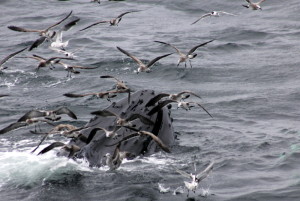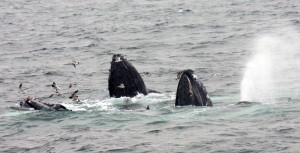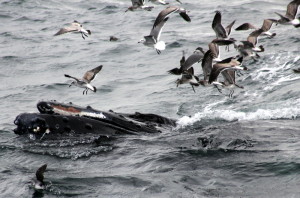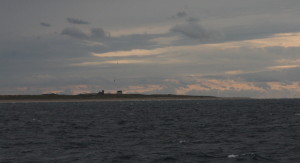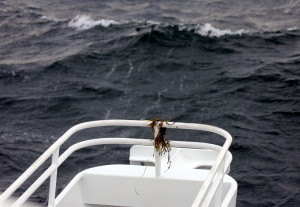October 10 – October 15
October 10 was a gray day, with winds blowing from the east, kicking up a big 4 – 6 foot swell. We chugged our away around Race Point, battling steady spray over the bow. Luckily, the whales weren’t too far beyond, and we were able to get good looks at three different species. Minkes, fin whales, and humpbacks are all baleen whales, using the bristly keratin plates in their mouth to filter their prey. As such, they have similar diets and can often be seen in the same area when food is abundant. Today was one of those days.
The humpback whales included individuals like Aswan, Evolution, Degree and Manhattan, all of whom have been mainstays in the area for the past few weeks. But we also saw some flukes that we haven’t seen in a while, including Pitcher and Indiana, both born in 2007.
After traveling from group to group, we decided to head for home. Of course, this is just when the whales started to feed. First, we noticed the birds becoming more and more frantic, then we saw bubbles rising to the surface, followed by the open mouths of the humpbacks.
The sand lance, which is the primary prey item of humpback whales in the Gulf of Maine, will sometimes school at the surface, but at other times they will bury themselves in the sandy ocean floor bottom. The humpbacks will follow them wherever they go, and will even use their jaws to dig them out of their burrows. On this whale, you can see fresh scuff marks on its jaw from this feeding behavior.
October 12 brought winds which increased throughout the day. We had the same three whales on both trips. Hiatus, Goalpost, and an unidentified whale were on long, presumably foraging dives in the morning. By the afternoon, they were up at the surface for longer periods of time; however, they rarely fluked! We were especially excited to see Goalpost. This whale was rescued from an entanglement several weeks prior, and we were happy to see this whale in better shape.
The afternoon also brought great looks at a variety of birds. There were plenty of gannets, as well as phalaropes, whose distinctive call is often heard before these tiny birds are spotted. We counted at least 60 Manx shearwaters, a species that tends to displace the Great and Sooty shearwaters so common in the summer. We even spotted a lingering summertime species — a Wilson’s storm petrel. We remarked that it was the first time in a month that we had spotted one of these little birds. They are trans-equatorial migrants and usually start to head down to their southern hemisphere breeding and nesting grounds by the end of the summer, but it looks like this straggler was sticking around to get some final plankton meals!
The morning of October 13th was quiet, with only a few low-key humpback whales surfacing occasionally. By the afternoon, the activity picked up considerably, with many more individual humpbacks, as well as 10-12 Minke whales moving into the area. The uptick in our whale counts was surely driven by an influx of food, because as soon as we arrived on scene, the humpbacks began bubble feeding. Humpbacks use various strategies to aggregate their prey, and using bubbles is one of them. These whales will blow spiraling nets of bubbles to confuse and trap their prey — mostly pencil-sized sand-eels, before swallowing a whole mouthful. Humpbacks have the longest flipper of any other whale with respect to their size, and these flippers afford them a great deal of flexibility as they encircle and engulf big schools of fish.
Gray skies and hefty southwest winds meant that we were moving pretty slow on October 14th. Amazingly, there were about 10 – 15 Atlantic white-sided dolphins just past Long Point, just a few minutes into our trip. Unfortunately, the seas made it hard to stay with these animals for too long. To avoid the seas at Wood End, we had to head far to the west into Cape Cod Bay. The trip to Race Point which usually takes no more than 40 minutes took nearly twice as long! Once we got there, we were astounded to get a look at a Mola mola. These ocean sunfish can be hard to spot bobbing in the water on even the calmest days. The seaweed washing over the bow in the photo below says a lot about the conditions on the way out!
Once we swung around the back side of the Cape the seas were calmer by far. We found lots of bird life at the start, including lots of gannets, Manx shearwaters and terns. The substantial bird presence made it seem like a productive area, but we couldn’t find any whales to confirm that there was good food around. We headed east and then backtracked to an area just north of Race Point. Here, we had our first large whale sightings with good looks at several Minkes. Finally, we were able to locate a humpback and get a look at two fluking dives before heading back.
On October 15, our lone humpback from the day before was nowhere to be found, but we did find a good deal of Minke whales. At least 12 of them! Unlike humpback whales, Minke whales rarely fluke, so we can’t use their ventral markings to distinguish them as individuals. Like with many other types of cetaceans, we rely mostly on the size and the shape of their dorsal fins to identify them. These dorsal fins can be hard to distinguish, especially since Minkes are fast and elusive. However, in the past few years, Dolphin Fleet scientists have been trying to get photos of Minke whale dorsal fins to see if we can start to learn about individual habitat use the same way that we do with humpbacks. It’ll be a lot of work, but we’ll keep you posted on our progress!







